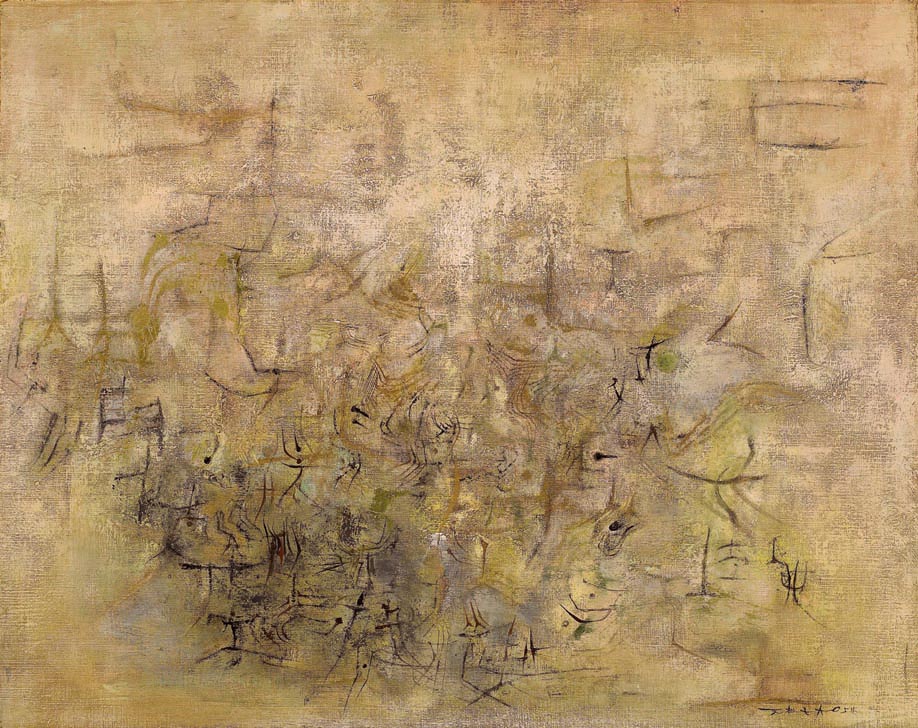Zao Wou-ki was born in 1921 into a literati family in Beijing; he studied calligraphy from a young age, and developed a passion for painting. At the age of 14, he enrolled at Hangzhou National College of Art, where he studied both Western and Chinese painting under noted artists such as Lin Fengmian, Wu Dayu and Pan Tianshou. During his time at the College, Zao studied the works of Paul Cézanne, Henri Matisse and Pablo Picasso, exploring the way in which they viewed the natural world. In 1948, when China was descending into the chaos of civil war, he decided to travel to Paris to undertake further study; it was this decision that set him on the road towards his future development as an abstract artist.
In Zao's paintings from the period 1948-1953, residual forms can still be made out; the influence of the artistic training that Zao had received in China is also very obvious. A visit to an exhibition of works by Paul Klee in Switzerland in 1951 was a revelation to him. Klee, who was fascinated by Asian art, displayed a freedom and lightness of touch in his paintings that made even the smallest canvas seem to embody vast, boundless spaces. Following Klee's example, Zao Wou-ki began to explore the utilization of two-dimensional symbols to represent color, and the use of poetic association. Benefiting from the inspiration that Klee's work had given him, and from his own travels around Europe to view famous buildings and murals, Zao began to move slowly towards his own emotive "universe of the self."
Subsequently, for a period of about two years, Zao Wou-ki painted large numbers of small canvases that featured still lifes, flowers, boats, scenic views, animals, etc., studying their composition and layout, and in doing so creating a kind of poetic space of his own. Gradually, the recognizable forms in his paintings began to disappear; he was no longer painting in a descriptive or representative manner, having turned instead to the use of symbols that were often difficult to decode, to express his own imagination. Almost all of Zao's works from this period have a monochromatic background. "Then, gradually, the symbols became forms, and the forms turned into space. As I painted, re-painted, gave up and started again, something was starting to emerge. It seemed as though my paintings were starting to move, to come to life. Forms burst out of the canvasses, and I found that I now dared to use colors that I had previously been nervous about using." (Zao Wou-ki & Françoise Marquet, Zao Wou-ki Autoportrait, éditions Fayard, Paris, 1988 p. 105)
In 1954, Zao Wou-ki began to create art that was wholly abstract, throwing off Klee's influence and developing his own, highly personal form of abstract painting. This is the period in which one starts to see paintings that could clearly be by no-one other than Zao Wou-ki! This particular work, "Paysage Abstrait" (Abstract Landscape), dates from 1954, making it one of Zao's earliest fully-abstract paintings. There are no recognizable physical objects in the painting, which is shot through with symbols and images that resemble some ancient script. These symbols in fact derive from the ancient "oracle bone script" of the Shang Dynasty; they recall the mystery of the inscriptions on bronze vessels from China's Bronze Age. Linking the past with the present, these symbols create a pulsating sense of vitality and energy. The background to the symbols is formed from multiple washes that display delicate variation in tone. The overall effect is restrained and elegant, with echoes of East Asian ink brush painting, although the rich colors and sense of light derive from the Western painting tradition.
In an article about Zao Wou-ki's paintings from this period that was published in the Parisian art journal Arts in 1955, the French art critic Alain Jouffroy outlined what it was that made Zao's work from this era so special: "In Zao Wou-ki's work one can see how the Chinese vision of the universe, where flow and distance reflect the spirit of contemplation more than the object of contemplation, has been transformed into a modern vision of universal relevance." Zao Wou-ki played a significant role in the abstract art movement that flourished in the 1950s in Europe and North America. He brought modernism into traditional Chinese art, and created a fusion of the essential elements of Asian and Western culture that spurred the development of those cultural elements that the two traditions had in common, creating a kind of new abstract vision in the process. Zao's success in this endeavor has earned him an important place in the history of art.
